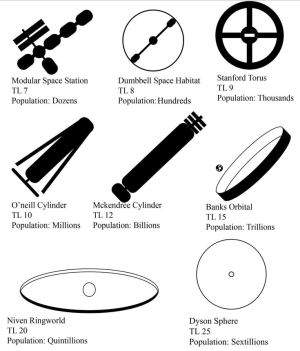But then it would have to be EVEN BIGGER!
Planetoid Hulls have a 20% "waste displacement" factor (in LBB5.80).
Buffered Planetoid Hulls have a 35% "waste displacement factor.
2.4 million / 0.8 = 3,000,000 tons
2.4 million / 0.65 = 3,692,308 tons
Granted, that's a "cheaper hull" than using a Metal Hull ... but still ...

A 216 meter diameter sphere has an internal volume of 42,213,400m
3 ... which divided by 14m
3 = 3,015,243 tons displacement ... sufficient for a Configuration: 8 (planetoid) hull containing 600,000 staterooms (and mostly NOTHING ELSE).
A 232 meter diameter sphere has an internal volume of 52,306,100m
3 ... which divided by 14m
3 = 3,736,150 tons displacement ... sufficient for a Configuration: 9 (buffered planetoid) hull containing 600,000 staterooms (and mostly NOTHING ELSE).
From a
COMBAT STARSHIP perspective, it sounds utterly ridonkulous ... since your starting point is in excess of 2.5 million tons!
But if you think of it in terms of needing to find a "1km diameter
M-type Asteroid" ... that if spherical would have a volume of 523,599,000m
3 ... which divided by 14m
3 =
37,399,928 tons displacement ...

Good luck finding a Jump Tender for something in that displacement class ...

Maneuver drive-ing such a large displacement locally around a solar system (at very low acceleration over a very long time frame) in order to place it into a desired orbit elsewhere, however ... would be quite doable. EXPENSIVE ... but doable as a megaproject.
However, even as a Configuration: 9 (buffered planetoid) you would still have up to
24,309,953 tons displacement available ... at which point 2,400,000 tons dedicated to 600,000 staterooms suddenly turns into
a mere 10% of the available habitat volume inside a "1km diameter
M-type Asteroid" ...

For reference, the
16 Psyche asteroid is [best ellipsoid fit = 277 km × 238 km × 168 km] within the planetoid belt of the Terra system.
My point being that a "1km diameter
M-type Asteroid" wouldn't even necessarily be that extraordinary or exceptional in terms of its size in astronomy terms, even in a star system lacking a Planetoid Belt. Such an object could presumably be found orbiting the trojan points of a gas giant (at L4 or L5) and maneuvered (with enough acceleration and time) into an L4/L5 position relative to a major moon of the same gas giant. Such a megaproject could easily take years (personally, I'd want a decade, minimum, just for the maneuvering phase) ... but is definitely something that would be within the budget of a megacorporation that wants to set up their own fiefdom somewhere and has the long term vision to execute such an endeavor. Initial capital outlays for such a megaproject would be ... astronomical ... but when you think in terms of building an outpost that will last for centuries(!), during which time it will (hopefully) generate sufficient economic revenue to "pay for itself" over a longer time horizon (say, a century or two) ... then such an investment ought to have long term payoffs that make the whole venture profitable (eventually).
A million tons here, a trillion credits there ... pretty soon we'll start talking in terms of real
RU!




